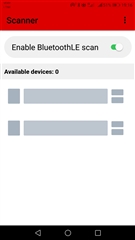Other Parts Discussed in Thread: CC2340R5
Hi all (and Tony Cave, I hope you are the same TC listed in the app credits and as support in the Google Store), I have the same exact issue as reported in:
This happens with the latest SimpleLink Connect v1.3.3 app on both Android phones I have available, on the opposite end of the OS version timeline (Honor 6X with Android 8 and Samsung A22 with Android 13). This issue did not occur with a previous version of the app that I had tried a few months ago. All requested permissions have been enabled (at least the requested ones, including storage (on Android 8), position and nearby devices (on Android 13)), BLE (obviously) on like cellular data, all default settings (only "skip tutorial at start" and "remove inactive devices"), app uninstalled, cache and data memory cleaned and reinstalled, unsuccessfully. Here are my screenshots:
Honor 6X (Android 8)

Samsung A22:

It seems that the thread that I have pointed to earlier has been marked as resolved two months ago, but apparently it hasn't been fixed. Please, if possible, advise ASAP, since I need to go through OAD development for my framework and app on the CC2340R5. Also, I can't seem to follow the very brief tutorial on:
https://github.com/TexasInstruments/simplelink-connect
The app build aborts, after a lot of dependency and versioning hell in setting up the environment according to the suggested steps on Linux Mint 21.2 (base: Ubuntu 22.04 Jammy LTS). It would be super useful if there could be a more detailed and Academy/Lab style step-by-step tutorial (for SimpleLink Connect app study and modification) that one could take in parallel with a React Native one. Could Tony help us by giving more details?
Thank you for your help, kind regards
Stefano


